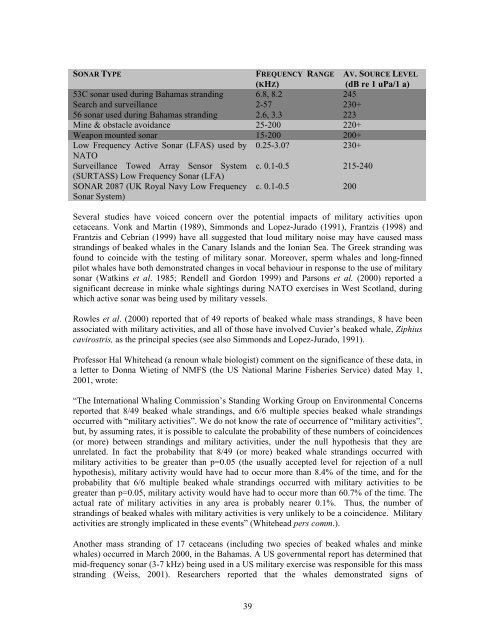Oceans of noise - Whale and Dolphin Conservation Society
Oceans of noise - Whale and Dolphin Conservation Society
Oceans of noise - Whale and Dolphin Conservation Society
You also want an ePaper? Increase the reach of your titles
YUMPU automatically turns print PDFs into web optimized ePapers that Google loves.
SONAR TYPE<br />
FREQUENCY RANGE<br />
(KHZ)<br />
AV. SOURCE LEVEL<br />
(dB re 1 uPa/1 a)<br />
53C sonar used during Bahamas str<strong>and</strong>ing 6.8, 8.2 245<br />
Search <strong>and</strong> surveillance 2-57 230+<br />
56 sonar used during Bahamas str<strong>and</strong>ing 2.6, 3.3 223<br />
Mine & obstacle avoidance 25-200 220+<br />
Weapon mounted sonar 15-200 200+<br />
Low Frequency Active Sonar (LFAS) used by 0.25-3.0? 230+<br />
NATO<br />
Surveillance Towed Array Sensor System c. 0.1-0.5 215-240<br />
(SURTASS) Low Frequency Sonar (LFA)<br />
SONAR 2087 (UK Royal Navy Low Frequency<br />
Sonar System)<br />
c. 0.1-0.5 200<br />
Several studies have voiced concern over the potential impacts <strong>of</strong> military activities upon<br />
cetaceans. Vonk <strong>and</strong> Martin (1989), Simmonds <strong>and</strong> Lopez-Jurado (1991), Frantzis (1998) <strong>and</strong><br />
Frantzis <strong>and</strong> Cebrian (1999) have all suggested that loud military <strong>noise</strong> may have caused mass<br />
str<strong>and</strong>ings <strong>of</strong> beaked whales in the Canary Isl<strong>and</strong>s <strong>and</strong> the Ionian Sea. The Greek str<strong>and</strong>ing was<br />
found to coincide with the testing <strong>of</strong> military sonar. Moreover, sperm whales <strong>and</strong> long-finned<br />
pilot whales have both demonstrated changes in vocal behaviour in response to the use <strong>of</strong> military<br />
sonar (Watkins et al. 1985; Rendell <strong>and</strong> Gordon 1999) <strong>and</strong> Parsons et al. (2000) reported a<br />
significant decrease in minke whale sightings during NATO exercises in West Scotl<strong>and</strong>, during<br />
which active sonar was being used by military vessels.<br />
Rowles et al. (2000) reported that <strong>of</strong> 49 reports <strong>of</strong> beaked whale mass str<strong>and</strong>ings, 8 have been<br />
associated with military activities, <strong>and</strong> all <strong>of</strong> those have involved Cuvier’s beaked whale, Ziphius<br />
cavirostris, as the principal species (see also Simmonds <strong>and</strong> Lopez-Jurado, 1991).<br />
Pr<strong>of</strong>essor Hal Whitehead (a renoun whale biologist) comment on the significance <strong>of</strong> these data, in<br />
a letter to Donna Wieting <strong>of</strong> NMFS (the US National Marine Fisheries Service) dated May 1,<br />
2001, wrote:<br />
“The International Whaling Commission’s St<strong>and</strong>ing Working Group on Environmental Concerns<br />
reported that 8/49 beaked whale str<strong>and</strong>ings, <strong>and</strong> 6/6 multiple species beaked whale str<strong>and</strong>ings<br />
occurred with “military activities”. We do not know the rate <strong>of</strong> occurrence <strong>of</strong> “military activities”,<br />
but, by assuming rates, it is possible to calculate the probability <strong>of</strong> these numbers <strong>of</strong> coincidences<br />
(or more) between str<strong>and</strong>ings <strong>and</strong> military activities, under the null hypothesis that they are<br />
unrelated. In fact the probability that 8/49 (or more) beaked whale str<strong>and</strong>ings occurred with<br />
military activities to be greater than p=0.05 (the usually accepted level for rejection <strong>of</strong> a null<br />
hypothesis), military activity would have had to occur more than 8.4% <strong>of</strong> the time, <strong>and</strong> for the<br />
probability that 6/6 multiple beaked whale str<strong>and</strong>ings occurred with military activities to be<br />
greater than p=0.05, military activity would have had to occur more than 60.7% <strong>of</strong> the time. The<br />
actual rate <strong>of</strong> military activities in any area is probably nearer 0.1%. Thus, the number <strong>of</strong><br />
str<strong>and</strong>ings <strong>of</strong> beaked whales with military activities is very unlikely to be a coincidence. Military<br />
activities are strongly implicated in these events” (Whitehead pers comm.).<br />
Another mass str<strong>and</strong>ing <strong>of</strong> 17 cetaceans (including two species <strong>of</strong> beaked whales <strong>and</strong> minke<br />
whales) occurred in March 2000, in the Bahamas. A US governmental report has determined that<br />
mid-frequency sonar (3-7 kHz) being used in a US military exercise was responsible for this mass<br />
str<strong>and</strong>ing (Weiss, 2001). Researchers reported that the whales demonstrated signs <strong>of</strong><br />
39

















